Are you in the mood for something delicious and satisfyingly spicy?
Look no further than Bihun Goreng, a traditional Indonesian dish that is sure to delight your taste buds.
This flavorful dish is made with rice vermicelli noodles, sautéed vegetables, and a variety of spices that create a perfect blend of sweet, sour, and spicy flavors.
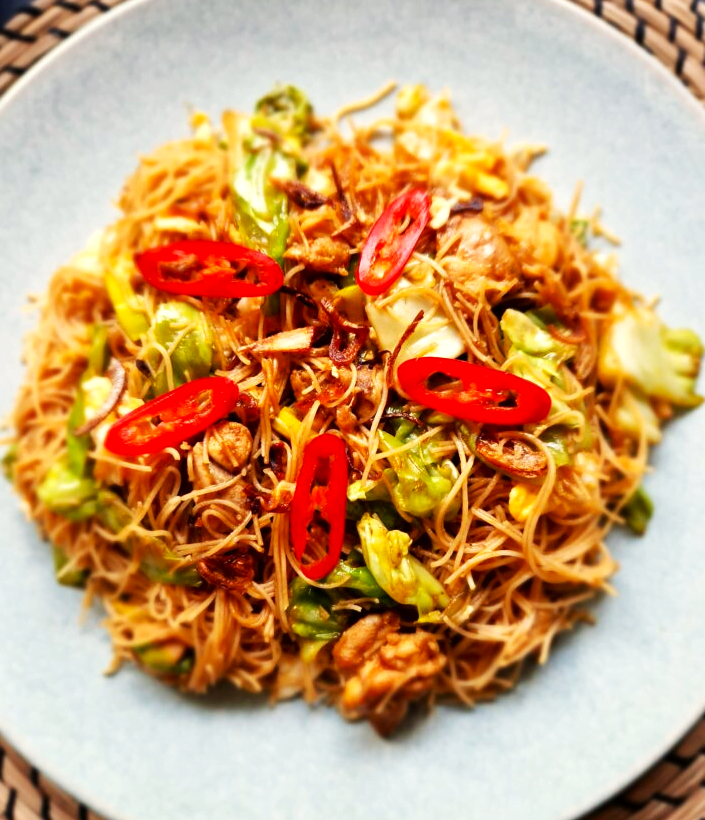
Whether you’re a seasoned cook or a beginner in the kitchen, Bihun Goreng is a dish that is easy to make and guaranteed to impress.
So, let’s get started on this culinary adventure and learn how to make Bihun Goreng!
What is Bihun Made Of?
Bihun is a type of thin rice vermicelli noodle that is commonly used in Southeast Asian cuisine.
It is made from rice flour and water, which are mixed to form a dough. The dough is then extruded through tiny holes to create thin, spaghetti-like noodles.
The noodles are then dried and can be stored for later use.
Bihun is a popular ingredient in dishes such as Bihun Goreng (fried rice vermicelli noodles), Bihun Soup (rice vermicelli noodle soup), and Bihun Salad (rice vermicelli noodle salad). It is gluten-free and an excellent alternative to wheat-based noodles for those with gluten sensitivities.
Don’t forget to check out my Salmon fish head soup and Soto ayam recipes.
What is Bihun Packed With?
Bihun Goreng is a gluten-free alternative to wheat-based noodles and is low in fat and calories.
It is a good source of carbohydrates, which provide energy to the body.
It’s packed with various ingredients, making it a tasty and satisfying dish. Below are some of the ingredients commonly used in Bihun Goreng and their nutritional benefits:
- Vegetables: Bihun Goreng typically includes a variety of vegetables, such as carrots, bell peppers, green beans, and onions. Vegetables are a great source of vitamins, minerals, and fibre, which help to support overall health.
- Soy sauce: Soy sauce is a flavorful ingredient in Bihun Goreng and is a good source of protein and amino acids. It also contains antioxidants that help to protect the body against oxidative stress.
- Kecap manis (sweet soy sauce): Kecap manis is a sweet and savoury sauce commonly used in Indonesian cuisine. It is a good source of iron and potassium, which help to support healthy blood pressure and red blood cell production.
- Sambal oelek (chilli paste): Sambal oelek is a spicy chilli paste commonly used in Indonesian cuisine. Chilli peppers contain capsaicin, a compound that has anti-inflammatory and antioxidant properties.
Is Bee Hoon and Vermicelli the Same?
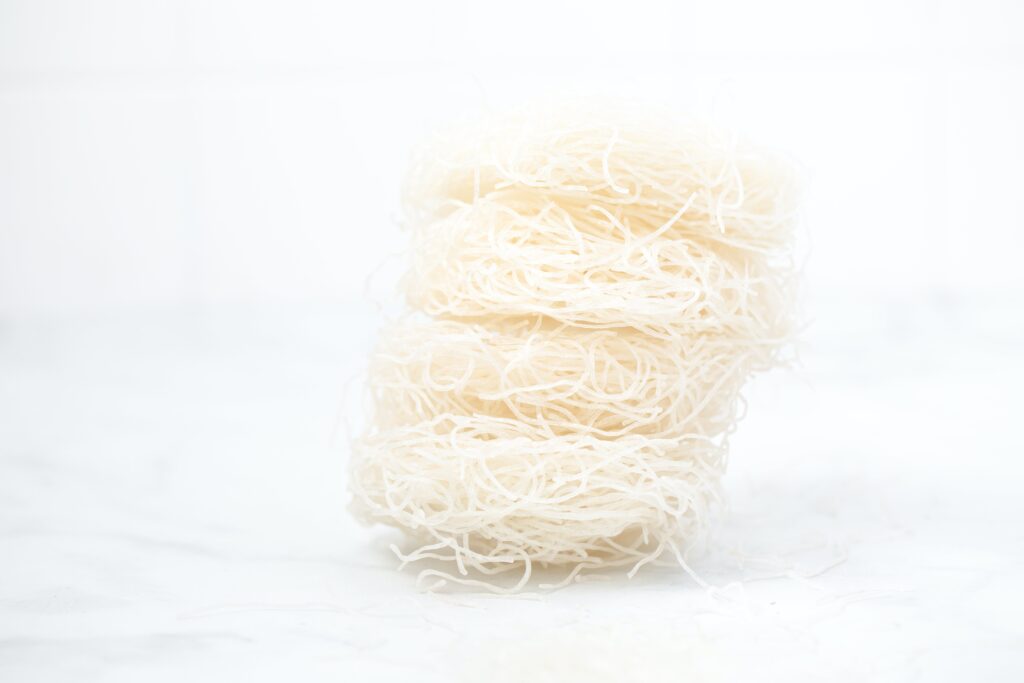
Yes, Bee Hoon and Vermicelli are the same thing.
Bee Hoon is the Malay term for thin rice vermicelli noodles commonly used in Southeast Asian cuisine, while Vermicelli is the Italian term for the same type of noodle.
The terms are interchangeable and refer to the same type of thin, spaghetti-like rice noodles.
What is the Difference Between Beehoon and Meehoon?
Beehoon and Meehoon are both types of rice vermicelli noodles used in Southeast Asian cuisine, but they differ in thickness.
Beehoon is thinner and is commonly used in dishes such as laksa and Bihun Soup.
Meehoon is slightly thicker and is used in dishes such as Mee Goreng and Hocken Mee.
The difference in thickness can affect the texture of the dish, with Beehoon having a softer, more delicate texture and Beehoon having a slightly chewier texture.
Beehoon and Meehoon are made from gluten-free rice flour, making them a popular alternative to wheat-based noodles for those with gluten sensitivities.
Is Bee Hoon Better than Rice?
Bee Hoon, also known as rice vermicelli noodles, is made from rice flour and water, making it a gluten-free alternative to wheat-based noodles.
While Bee Hoon is a tasty and versatile ingredient, it is not necessarily worse or better than rice.
Bee Hoon is a low-calorie and low-fat food, making it a good choice for those who are watching their calorie and fat intake. It is also a good source of carbohydrates, which provide energy to the body.
Rice, on the other hand, is a staple food in many cultures around the world, and it is a good source of fiber, vitamins, and minerals.
Brown rice, in particular, is a good source of fiber and has a lower glycemic index than white rice, making it a good choice for those trying to manage their blood sugar levels.
In a nutshell, both Bee Hoon and rice can be part of a healthy and balanced diet.
While Bee Hoon is a good low-calorie and low-fat alternative to rice, it lacks some of the essential nutrients found in rice.
On the other hand, rice is a good source of fiber, vitamins, and minerals, making it a healthy choice for many people.
As with any food, it is essential to consume Bee Hoon and rice in moderation as part of a balanced diet.
10 Tips and Tricks for Making the Best Bihun Goreng
1. Soak the rice vermicelli noodles in warm water for at least 10 minutes before cooking. This will help to soften them and prevent them from becoming too mushy when cooked.
2. Use fresh vegetables, such as carrots, cabbage, bell peppers, and green beans, to add colour and texture to your Bihun Goreng. You can also add other vegetables, such as mushrooms or broccoli, to customize the dish to your liking.
3. Use a wok or large skillet to cook the Bihun Goreng. This will allow you to cook the noodles and vegetables evenly and quickly.
4. Use high heat when cooking the Bihun Goreng. This will help to create a delicious smoky flavour and prevent the noodles from becoming soggy.
5. Use a combination of sweet, sour, and spicy flavours to create a perfect balance of flavours in your Bihun Goreng. To achieve this balance, you can use ingredients such as kecap manis (sweet soy sauce), lime juice, and sambal oelek (chilli paste).
6. Don’t overcook the vegetables. You want them to be slightly crispy and retain their texture, so be sure to cook them for just a few minutes.
7. Use a variety of proteins, such as shrimp, chicken, or tofu, to add flavour and protein to your Bihun Goreng.
8. Use high-quality oil, such as peanut or vegetable oil, to cook the Bihun Goreng. This will help to create a delicious and authentic flavour.
9. Garnish your Bihun Goreng with fresh herbs, such as cilantro, chilli or green onions, to add a pop of colour and flavour.
10. Be bold and experiment with different ingredients and flavors to create your own unique version of Bihun Goreng. Add your own twist and enjoy the delicious results!
Storage and Reheating of Bihun Goreng
Bihun Goreng, like most noodle dishes, can be stored and reheated for later consumption. Here are some tips on how to store and reheat Bihun Goreng:
1. Storage: To store Bihun Goreng, transfer the leftovers to an airtight container and refrigerate it as soon as possible. The Bihun Goreng can be stored in the refrigerator for up to 3 days.
2. Reheating: To reheat Bihun Goreng, you can use a microwave or a stovetop. If you are using a microwave, transfer the Bihun Goreng to a microwave-safe dish and cover it with plastic wrap or lid. Microwave for 1-2 minutes on high.
3. Stovetop: If you are using a stovetop, heat a small amount of oil in a non-stick pan over medium-high heat. Add the Bihun Goreng to the pan and stir-fry for 2 to 3 minutes or until heated. You can also add a small amount of water or chicken broth to help rehydrate the noodles.
4. Add Fresh Ingredients: To refresh the flavours of the dish, you can add fresh herbs such as cilantro, green onions, or chopped peanuts on top of the reheated Bihun Goreng.
5. Avoid Overcooking: When reheating Bihun Goreng, it is essential to avoid overcooking the noodles. Overcooking can make the noodles mushy and affect the texture of the dish. Be sure to heat the Bihun Goreng just until it is heated through, and avoid cooking it for too long.
By following these tips, you can store and reheat your Bihun Goreng for a delicious and convenient meal that is ready whenever you are.

Bihun Goreng
Ingredients
Method
- Soak the rice noodle by placing them in a bowl and add warm water until the noodles are completely covered. Let the noodles soak for about 10 minutes, then drain well. Do not boil your vermicelli for this recipe as boiling will give you soggy noodles.

- Mix together your noodle sauce ingredients.
- Heat about 1 or 2 tbsp of oil over medium-high heat in a wok or pan. Once the oil is hot, add the bitten eggs and scramble until cooked. Remove the eggs from the pan and put aside.

- Next, in the same pan or wok over medium-high heat, add 2/3 tbsp vegetable oil. When the oil is hot, add the ground spices and sauté for a minute or until fragrant.

- Add chicken or shrimp. sauté the chicken or shrimp until 80% cooked. And add the cabbage and sauté for 30 seconds to one minute. Add the prepared sauce and bring to a simmer.

- Add the scramble egg. Then, add the soaked vermicelli noodles. Stir well so the noodles are well coated.
- Add the green onion, stir fry and cook for another minute until the green onions are no longer raw.
- Correct the taste and turn off stove.
- Finish by adding a sprinkle of fried shallot and sliced of chilli for a garnish and serve immediately.

- I hope you like it and Enjoy!
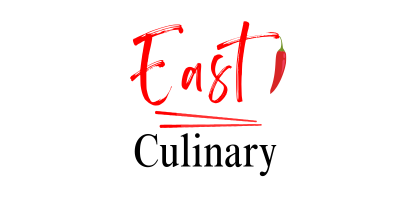

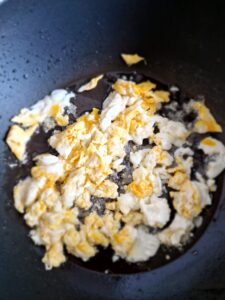
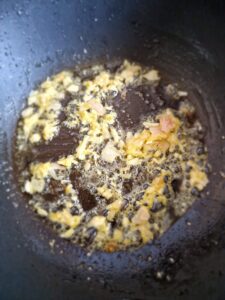
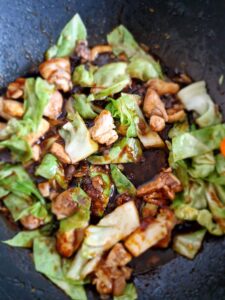
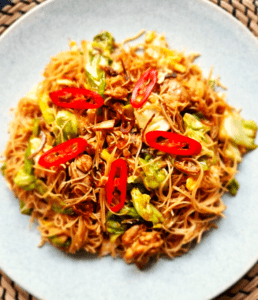

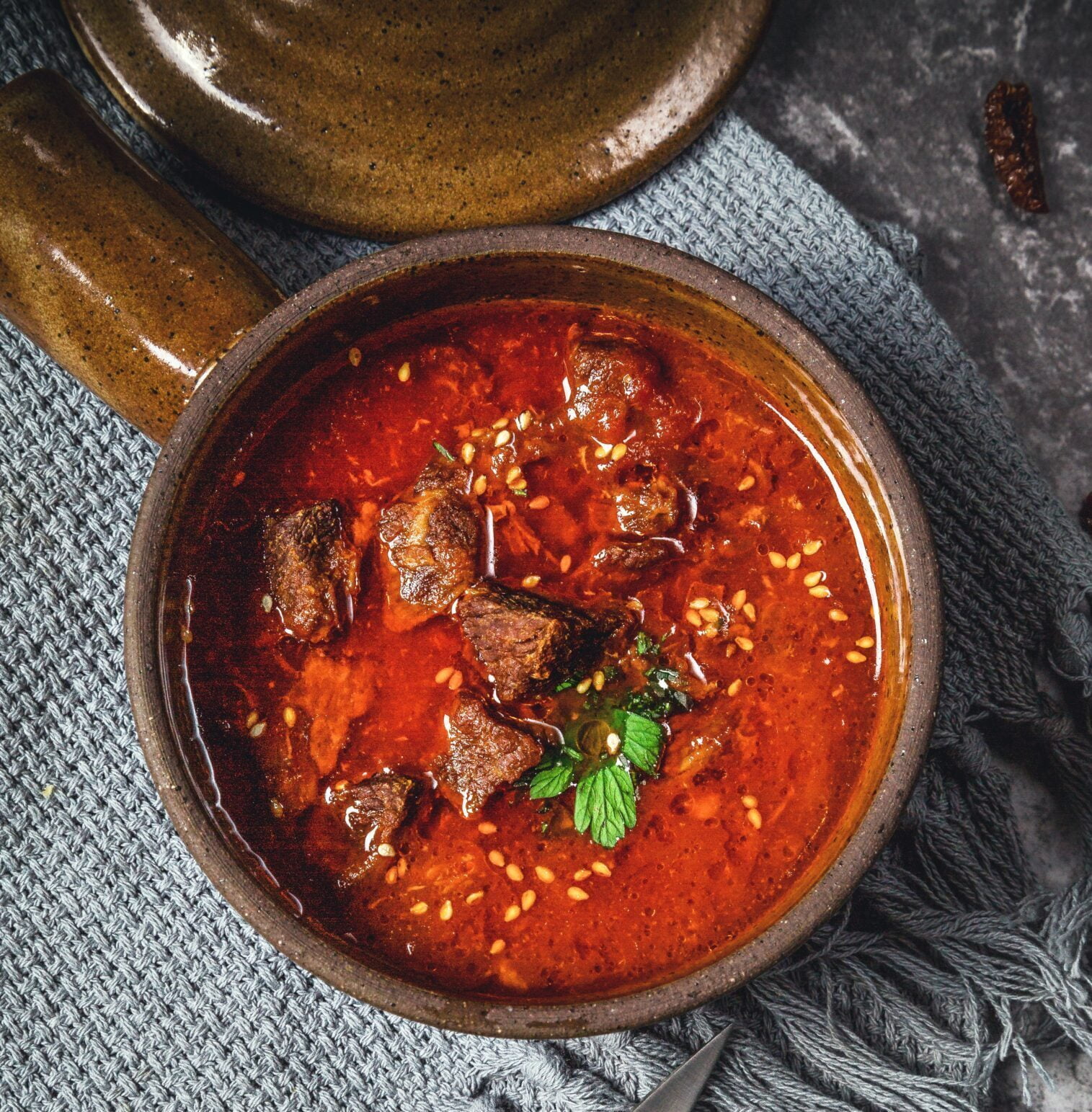
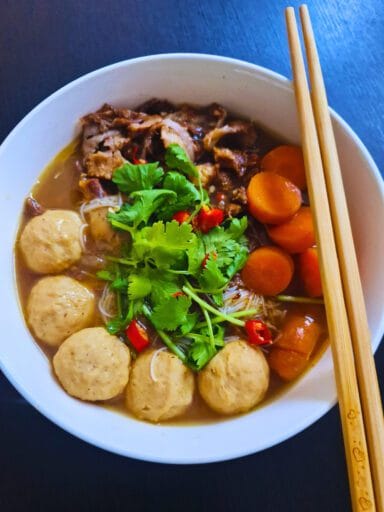
Delicious food!